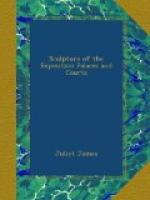A. Stirling Calder
The man at the wheel in the management of all the works of sculpture at the Panama-Pacific International Exposition has been A. Stirling Calder. He was born at Philadelphia in 1870. Having studied four years at the Pennsylvania Academy of Fine Arts, he had the advantage of two years in Paris. For some time he has been connected with the Philadelphia School of Industrial Arts. He is a man of splendid imagination, of dignified and noble purpose, being one of the sincere men of his art who keeps the standards where they should be. One of his early works, “The Man Cub,” in the Pennsylvania Academy of Fine Arts, is most original and interesting in its treatment. It stands a most unique figure in the line of sculpture. It is said that his “Martha W. Baldwin Memorial” is one of the best designs for a figure and pedestal yet produced in America. Mr. Calder lived some time in southern California and when there did the sculptured work on the portico of Throop Polytechnic Institute of Pasadena. This work was done by means of enormous castings made in fine concrete. Mr. Calder originated this method and it will probably be the means of revolutionizing the relief work done on many of the public buildings in the future. Mr. Calder’s rare intellectual fiber, added to his accurate knowledge of his subjects, with his exalted outlook, has placed him among the foremost American sculptors.
James Earle Fraser
James Earle Fraser was born at Winona, Minnesota, in 1876. His father was a railroad constructor, so that the lad had a good chance in traveling around the country to study the free types and life of the West. Being very impressionable, he imbibed a great deal which he has turned to good account in his chosen work. At fourteen he started to carve figures from the chalk that conventionality required to be used on blackboard problems. At eighteen he entered the Chicago Art Institute, where he stayed for but three months. He soon went to Paris, going first to the Beaux Arts and later to the Colorossi and Julian Academies. He won many honors during his three years stay in Paris. In 1898 he won the prize offered by the American Art Association in Paris for the best work in sculpture. Augustus Saint-Gaudens was on the jury and immediately became interested in the talented boy who later on held the place of chief assistant in the Saint-Gaudens studio. He became instructor of the Art Students’ League of New York in 1906, holding the position until 1911. He it was who made the new five-cent piece design — the Indian head on one side, the bison on the other. He is particularly interested in personalities, having done a number of very clever portrait busts. It is enough to look at the portrait bust of Mrs. Harry Payne Whitney’s boy to realize what he is able to do in the line of portraiture. He has produced nothing finer in that line. He is a master of character records.




